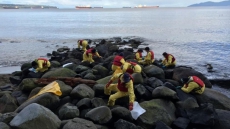HALIFAX — There were no mechanical problems with an Air Canada passenger jet that crashed about 200 metres short of the runway at the Halifax airport in March, the Transportation Safety Board says in a preliminary report released Tuesday.
The independent board issued a statement saying the Airbus 320-200 was correctly configured for landing, its air speed was consistent with a normal approach and there were no mechanical deficiencies with its engines, flight controls, landing gear and navigation systems.
"During the review of the aircraft's maintenance records, no discrepancies were noted," the board said.
However, the board confirmed that the weather was poor at the time.
At 12:15 a.m. local time on March 29, the wind was gusting at 48 kilometres per hour from the north-northwest and forward visibility was 800 metres amid snow and drifting snow, the statement says.
As well, the board says vertical visibility above the ground was just 91 metres.
The jet's flight-data recorder and cockpit voice recorder have been examined, but the board says it has yet to look into pilot training, experience and "human performance aspects."
The board's ongoing investigation will also include producing an animation of the flight profile, completing a site survey illustration, examining key aircraft components and reviewing cabin crashworthiness and the passenger evacuation procedures, among other things.
"Should the investigation team uncover a safety deficiency that represents an immediate risk to aviation, the board will communicate without delay so it may be addressed quickly and the aviation system made safer," the board says.
Flight 624 from Toronto had 133 passengers and five crew members on board.
During its approach to Halifax Stanfield International Airport, the aircraft was being guided to Runway 05 by a so-called localizer approach procedure. This procedure provides pilots with only lateral guidance to align the aircraft with the runway, the board said.
As the plane neared the runway at low altitude, its engines severed overhead power lines, cutting power to the airport, and the jet's main landing gear and rear fuselage hit the snow-covered ground about 225 metres before the runway threshold.
The aircraft then struck a localizer antenna and hit the ground in a "nose-down attitude" about 70 metres before the runway threshold, the board says.
"It then bounced and slid along the runway, coming to rest on the left side of the runway about 570 metres beyond the threshold," the report says. "The passengers and crew evacuated the aircraft; 25 people sustained injuries and were taken to local hospitals."
Though the airliner was badly damaged, there was no fire.
A subsequent examination of the fuselage showed the cabin floor had been punctured from below in two places by "aircraft structure."





